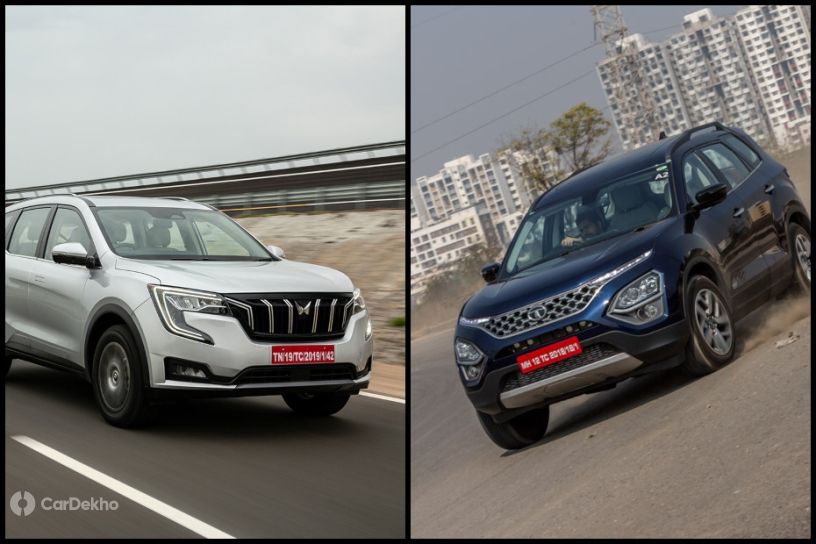Mahindra XUV700 vs Tata Safari: In Pics
Modified On Sep 14, 2021 12:12 PM By Sonny
- Write a comment
How does Mahindra’s future icon measure up against the Tata flagship?

The Mahindra XUV700 has finally made its debut, and it offers an impressive package with its various segment-first features, muscular design and proportions, and strong performance. Most impressive of all seems to be its introductory pricing which starts from Rs 11.99 lakh (ex-showroom). However, at the top end, with all the best features and comforts, it will be taking on other three-row, mid-size SUVs such as the Tata Safari. While a detailed comparison is a while away, let’s compare the two SUVs’ exteriors, interiors and features in the gallery below:
EXTERIOR
Front


The XUV700’s front end looks chiseled in comparison to the Safari’s puffy cheeks. Its larger black grille with the spaced-out silver slats takes centrestage while most of the Safari’s front end is dominated by the cladding and faux front skid plate. The C-shaped LED daytime running lights give the XUV700 some definition while the bottom of the front end has a clear edge, with the blacked-out air dam and fog lamp housing adding to the sporty look of the Mahindra.
Headlamps


The XUV700 has a traditional headlamp position, just below the bonnet line, while the Safari’s front lights are lower and on the bumper. The LED DRLs are directly around the XUV700’s LED headlamps with dynamic turn indicators integrated into the design as well. Tata’s SUV has the DRLs flanking the grille which also act as the turn indicators while the Xenon HID projector headlamps are housed separately.
Side


The character lines of the XUV700 accentuate the muscular definition around the flared wheel arches, especially at the rear where the shoulder line rises up to the window line. Meanwhile, the Safari looks just as muscular in profile but has sculpted curves instead.
It’s easy to see here that the XUV700 and Safari are quite similar in size. The Mahindra is 34mm longer overall, but its wheelbase is longer by just 9mm, while the Tata SUV is 31mm taller. The Safari’s rear end looks boxy and upright in comparison to the XUV700 where the roofline seems a bit sportier thanks to the slope of the window line and the blacked-out rear pillars.

The XUV700 also gets to show one of its special features from this angle: door handles that sit flush into the body work for an uninterrupted design.
Rear


Comparing the rears of these SUVs is similar to comparing their fronts. The XUV700 has more definition to its design with the creases and cutaways while the Safari looks chunkier as it spreads outwards from the top to the bumper. The larger tail lamps on the Mahindra also break the monotony of the bodywork while the Tata’s sleeker taillights are connected by a black bar for a more modern look.
Taillamps


Mahindra calls these the arrow-head LED taillamps due to their shape and styling. There are many sections for the different functions and are well integrated into the design. The Tata Safari’s LED taillights are sleeker, with the two lines being the centrepiece for the light signature.
Wheels


Both the XUV700 and Safari get 18-inch alloys but have very different styling.
INTERIOR


Both the XUV700 and Safari have a premium cabin, but the Mahindra SUV’s dashboard looks like it’s a step up above thanks to its digital cockpit setup comprising two 10.25-inch displays: one for the touchscreen infotainment system and one for the driver’s display. Both have a dual-tone cabin with a mix of cream upholstery, dark plastics and wooden inlays.
Also read: Here’s A Look At The Standout Features Of Each Variant Of The Mahindra XUV700


The XUV700’s infotainment system packs a lot of cool features thanks to Mahindra’s new AdrenoX UI and integrated Amazon Alexa for the voice-enabled functionalities. The Safari has an 8.8-inch touchscreen infotainment display integrated into the same piano black housing as the central AC vents. It also has an array of physical controls and dials not seen on the XUV700.
Related: Amazon Alexa-Powered ‘AdrenoX’ Infotainment System To Power The Mahindra XUV700


Mahindra has fitted the XUV700 with a 10.25-inch digital display that has multiple screen layouts depending on the information you want to see but the speedometer and tachometer readouts stay on either side of the screen. In the Safari, Tata offers a semi-digital cluster with a 7-inch multi-information display and an analog speedometer on the right.


Both SUVs offer 6-way power adjustable front driver seats.

However, the XUV700’s power-adjustable driver’s seat gets the addition of a memory function which can record up to three seat positions. This is especially handy if multiple people drive the car and each person’s preference can be saved for the next use.


The XUV700 is equipped with dual-zone climate control and hence has two temperature dials on the console. The layout looks more organised than the climate control panel of the Safari.


The central console tunnel of both cars is very different. Mahindra’s design seems more ergonomic for accessing the storage tray ahead, which also has a wireless charging pad, and another smartphone holster. It is more symmetrical too, with the rectangular layout split into sections for the drive selector knob, electronic parking brake, cup holders and a rotary dial (that can be used to navigate the infotainment system or adjust volume) with shortcuts for the infotainment system. Meanwhile, the Tata Safari’s central console is more linear in its layout, starting with the rotary dial for the traction modes (Terrain Response), the drive-selector, and then the electronic parking brake.

Both SUVs offer a panoramic sunroof but Mahindra claims that the XUV700’s is larger.


The XUV700’s middle bench gets the benefit of a headrest for the middle seat over the Safari. Both offer a fold-out arm rest as well as a 60:40 split folding function.

This allows the seat to be tip-and-tumble forward, when accessing the third row.

While the XUV700 will be available in both five- and seven-seater configurations, the Safari comes only in a three-row SUV guise, besides getting the more premium option of a six-seater layout with captain seats in the middle row.


The third row of both SUVs seems quite similar but with different amounts of bolstering and headroom. They get three-point seatbelts, can be split-folded 50:50, have an armrest either side, dedicated vents with blower controls and some storage space too.


Mahindra has not specified the boot capacity of the XUV700 yet but it’ll be fairly low with all three rows of seats in use. It’s a similar story with the Tata Safari.


With the third row of seats folded down, there is plenty of luggage room in both SUVs. The Safari’s floor seems to lie flatter than that of the XUV700, which could make it easier to carry large, flat items like furniture or heavy appliances.
Final Thoughts
The Mahindra XUV700 has certainly made the most of its delayed arrival by offering more than its intended rivals and to distinguish itself visually as well. While each car has its pros and cons in terms of the exterior or interior, other deciding factors such as driving experience and price comparisons can only be discussed at a later date. In the meantime, do let us know in the comments the SUV you prefer the look of, and why.
Read More on : XUV700 on road price
7 out of 8 found this helpful















